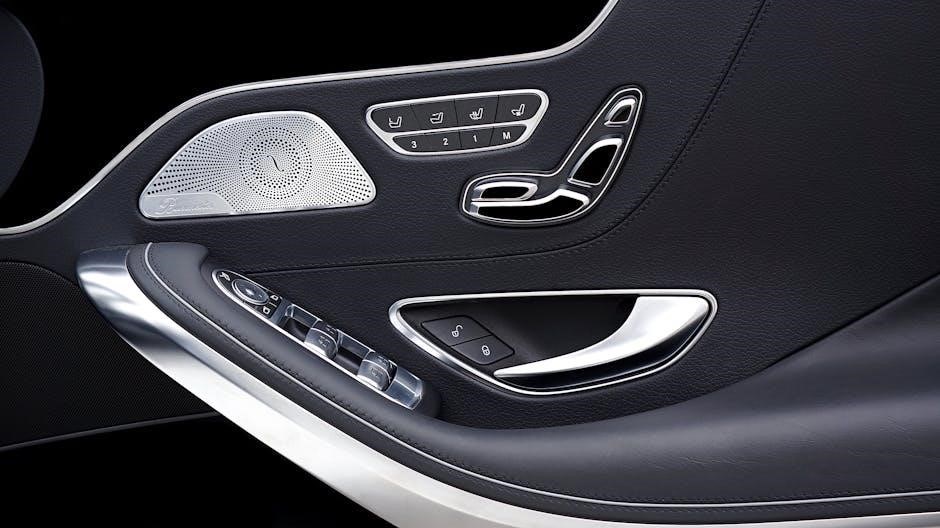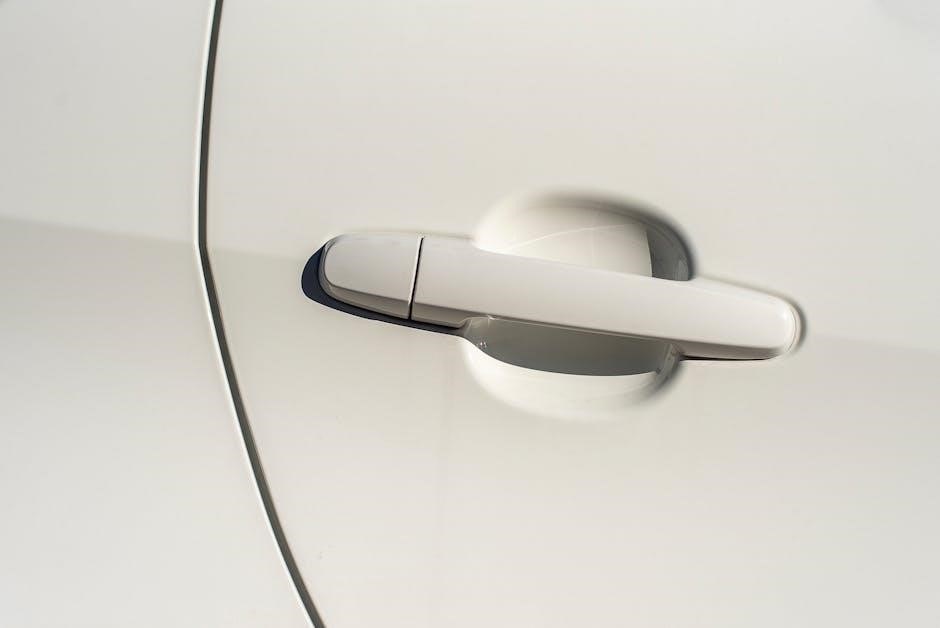Door closer adjustment ensures smooth, controlled closure, preventing slamming and ensuring proper latching. Proper adjustment is crucial for safety, accessibility, and preventing wear and tear on the door and frame.
1.1 What Is a Door Closer?
A door closer is a mechanical or hydraulic device attached to a door to regulate its closing motion. Its primary function is to ensure the door closes smoothly and securely, controlling the speed and force. Commonly mounted on the door frame or concealed within the door, it prevents slamming and ensures proper latching. Available in various types, including surface-mounted and concealed models, door closers are essential for maintaining door functionality and longevity, while also enhancing safety and accessibility in commercial and residential settings.
1.2 Importance of Proper Adjustment
Proper door closer adjustment is crucial for ensuring smooth operation, safety, and longevity. Incorrect settings can lead to slamming, incomplete latching, or excessive force, potentially causing damage or injury. A well-adjusted closer enhances accessibility, especially for the elderly or disabled, by controlling closing speed and force. It also prevents wear and tear on door frames and hinges. Regular adjustment ensures compliance with safety standards and maintains energy efficiency by sealing gaps properly. Proper adjustment is key to balancing functionality, safety, and durability in any setting.
Essential Components of a Door Closer
A door closer consists of hydraulic valves, springs, and an arm mechanism. These components work together to regulate closing speed, latch speed, and backcheck, ensuring smooth operation.
2.1 Types of Door Closers
Door closers are available in various types, including surface-mounted, concealed, and overhead models. They can be mechanical or electromagnetic, with some featuring delayed action for accessibility. Surface-mounted closers are the most common, while concealed closers provide a sleek look. Overhead closers are ideal for heavy-duty applications. Each type offers unique benefits, catering to different door sizes, traffic levels, and aesthetic preferences, ensuring versatile solutions for various settings.
2.2 Key Parts of a Door Closer
A door closer consists of several key components: the main body, arm, spring, adjustment screws, backcheck, and valve system. The main body houses the hydraulic mechanism, while the arm connects the closer to the door. The spring provides the closing force, and adjustment screws control the closing and latching speeds. The backcheck regulates the door’s opening angle, and the valve system manages hydraulic flow, ensuring smooth operation. These parts work together to automate door closure efficiently.
2.3 Functions of Each Component
The main body contains the hydraulic mechanism controlling door movement. The arm connects the closer to the door, enabling smooth operation. The spring generates closing force, while adjustment screws fine-tune closing and latching speeds. The backcheck prevents excessive door opening, protecting the frame. Valves regulate hydraulic fluid flow, ensuring precise control over door movement. Each part plays a vital role in maintaining proper door function, safety, and longevity of the closer and door system. Proper functionality relies on these components working harmoniously together.
Tools and Preparation
Essential tools include a screwdriver or hex key for adjustments. Ensure the door is secure and consult the manufacturer’s instructions for specific preparation requirements.
3.1 Tools Needed for Adjustment
The primary tools required for adjusting a door closer are a screwdriver or hex key, depending on the brand. Additional tools may include pliers, an Allen wrench, or a measuring tape. Ensure the door is secure and remove any obstructions. For precise adjustments, use the smallest turn possible (less than 1/8 of a turn) to avoid over-tightening. Always refer to the manufacturer’s instructions for specific tool recommendations.
3.2 Safety Precautions
Before adjusting a door closer, ensure the door is secure and clear of obstructions. Wear gloves and safety goggles to protect against potential mechanical hazards. Avoid over-tightening, as this can damage the closer or injury. Ensure the door is fully open or closed during adjustments to prevent accidental movement. Keep children and pets away from the area to avoid accidents. Always follow manufacturer guidelines and disconnect power if applicable.
Locating the Adjustment Screws
Adjustment screws are typically found on the door closer’s body, often concealed under protective covers. Use a screwdriver or hex key to access and modify settings.
4.1 Where to Find the Screws
The adjustment screws are typically located on the door closer’s main body, often hidden beneath a protective cover. They may be positioned on the top or side of the closer. To access them, you might need to remove a cover plate using a screwdriver. Some closers have screws visible without disassembly, while others require tools like a hex key. Always refer to the manufacturer’s instructions for specific locations, as designs can vary between brands and models.
4.2 Accessing the Screws
To access the adjustment screws, start by opening the door slightly or fully, depending on the closer’s design. Use a screwdriver or hex key, as specified by the manufacturer. Some closers require removing a cover plate, which may be held in place by screws or clips. Gently pry or unscrew the cover to expose the adjustment mechanism. For doors with high tension, consider holding the door open at a 1-inch gap to reduce resistance while accessing the screws.
Adjusting the Closing Speed
Adjusting the closing speed ensures the door closes smoothly and quietly. Minor adjustments are made by turning the adjustment screws, typically located on the closer’s body.
5.1 How to Adjust Closing Speed
Adjusting the closing speed involves locating the adjustment screws on the door closer. Turn the screw clockwise to slow the door or counterclockwise to increase the speed. Always test the door after each adjustment to ensure smooth operation and proper closure. Refer to the manufacturer’s instructions for specific guidance and safety precautions to avoid over-tightening or causing damage to the closer mechanism.
5.2 Tips for Testing the Speed
After adjusting the closing speed, open the door fully and observe its movement. Ensure it closes smoothly without excessive force or hesitation. Test multiple times to confirm consistent performance. If the door closes too quickly, slow it down by turning the adjustment screw counterclockwise. For faster closure, turn it clockwise. Always re-test after each adjustment to maintain optimal functionality and safety. Proper testing ensures the door operates efficiently and meets accessibility standards.
Adjusting the Latch Speed
Adjust the latch speed by turning the screw clockwise to slow down or counterclockwise to speed up. Test the door after each adjustment for smooth operation.
6.1 Understanding Latch Speed
Latch speed refers to the velocity at which the door closer powers the door through the final stages of closing to engage the latch. Proper adjustment ensures the door closes securely without slamming, preventing damage and wear. Improperly set latch speed can lead to issues like the door not latching fully or closing too forcefully, potentially causing noise or safety hazards. Adjusting this setting requires careful tuning to achieve the desired balance between security and ease of use.
6.2 Steps to Adjust Latch Speed
To adjust the latch speed, locate the designated adjustment screw on the door closer. Use a screwdriver to turn the screw clockwise to slow down the latch speed or counterclockwise to increase it. Make small adjustments (less than 1/8 of a turn) and test the door’s closing action after each change. Repeat until the door closes smoothly and latches securely without slamming. Ensure proper testing by opening the door fully and allowing it to close naturally to verify the adjustment.

Backcheck Adjustment
Backcheck adjustment regulates the door’s resistance to opening forces, preventing damage from strong winds or impacts. Adjust the backcheck valve to control the door’s swing momentum smoothly.
7.1 What Is Backcheck?
Backcheck is a feature in door closers that regulates the door’s resistance to excessive opening forces, preventing it from swinging too far or too quickly. It acts as a safety mechanism, protecting the door, frame, and surrounding structures from damage caused by strong winds, impacts, or heavy usage. The backcheck function is typically controlled by an adjustable valve within the door closer, allowing customization of the door’s behavior during its opening cycle. Proper adjustment ensures smooth operation and longevity of the door system.
7.2 How to Adjust Backcheck
To adjust the backcheck, locate the backcheck adjustment screw on the door closer. Open the door to the desired angle where resistance is needed. Use a screwdriver to turn the screw clockwise to increase resistance or counterclockwise to decrease it. Test the door by swinging it open to ensure it stops smoothly at the set angle. Fine-tune as necessary until the door’s opening motion is controlled and stable, preventing excessive movement without hindering normal operation.
Delayed Action Adjustment (If Applicable)
Delayed action slows the door’s closing after a certain angle, aiding accessibility. Adjust the dedicated valve to control the delay duration, ensuring smooth operation for all users.
8.1 What Is Delayed Action?
Delayed action is a feature in door closers that slows the door’s movement after it reaches a specific angle, typically between 70° and 90°. This function provides additional time for people to pass through the doorway, enhancing accessibility, especially for individuals with disabilities or those carrying items. It ensures the door closes smoothly without rushing, balancing convenience with security, and is commonly found in public and commercial settings.
8.2 How to Adjust Delayed Action
To adjust the delayed action, locate the specific valve or screw designated for this feature on your door closer. Turn the screw clockwise to slow down the door’s movement after the specified angle, or counterclockwise to speed it up. Make small adjustments, testing the door’s movement after each turn. Ensure the door closes smoothly and safely, providing adequate time for passage. Refer to your door closer’s manual for precise instructions, as mechanisms may vary by model.

Troubleshooting Common Issues
Identify issues like doors not closing properly or making noise. Check for misaligned brackets, worn seals, or loose screws. Adjust speeds or inspect for fluid leaks if erratic operation occurs.
9.1 Identifying Common Problems
Common issues with door closers include improper closing, excessive noise, or slow operation. Check for misaligned brackets, worn-out seals, or loose screws. Look for signs of fluid leaks, which can cause erratic behavior; If the door doesn’t latch properly, inspect the arm alignment. Noise may indicate worn components or incorrect adjustment. Addressing these problems early prevents further damage and ensures smooth functionality.
9.2 Diagnosing the Issue
Diagnosing door closer issues involves inspecting both the closer and door operation. Check for fluid leaks, which can cause erratic behavior. Inspect the closer’s arm alignment and connection to the door frame. Look for loose screws or worn components. Test the door’s closing force and speed to identify if adjustments are needed. Ensure proper alignment of the closer’s bracket and door frame. Verify the door’s hinge condition, as misaligned hinges can affect closer performance. Use these observations to pinpoint the root cause accurately.
9.3 Solutions and Fixes
Tighten any loose screws on the closer or door frame. Replace worn or damaged parts, such as the arm or seals, to restore proper function. Adjust the closing and latch speeds by turning the respective valves slightly. Lubricate moving parts to reduce friction. If fluid leakage occurs, replace the closer immediately. Ensure proper alignment of the closer and door frame. For persistent issues, consult the manufacturer’s instructions or consider replacing the entire unit if repairs are ineffective.

Maintenance Tips
Regularly inspect the door closer for fluid leaks, wear, or misalignment. Lubricate moving parts annually and tighten loose screws. Replace worn seals or components promptly to maintain optimal function.
10.1 Regular Maintenance
Regular maintenance ensures the door closer functions smoothly. Inspect for fluid leaks, wear, or misalignment. Clean the closer and arm regularly. Lubricate moving parts annually with silicone-based lubricant. Check adjustment screws for tightness and tighten if necessary. Replace worn-out seals or components promptly. Ensure proper alignment of the closer arm. Regular checks prevent unexpected failures and extend the lifespan of the door closer.
10.2 Signs of Wear and Tear
Signs of wear and tear on a door closer include fluid leaks, erratic operation, or visible damage to the closer body or arm. Difficulty in closing or opening the door smoothly may indicate worn-out parts. If the door slams shut or fails to latch properly, it could signal excessive wear. Regular inspections can help identify these issues early, preventing further damage and ensuring the door closer functions effectively over time.
10.3 When to Replace the Closer
Replace the door closer if it shows significant wear, such as fluid leakage, erratic operation, or visible damage to the body or arm. If adjustments no longer improve performance or if the door fails to close or latch properly, replacement is necessary. Persistent issues like slamming or difficulty in opening indicate the closer is no longer functioning effectively. Replacing it ensures safety, accessibility, and proper door functionality, preventing further damage to the door or frame.
